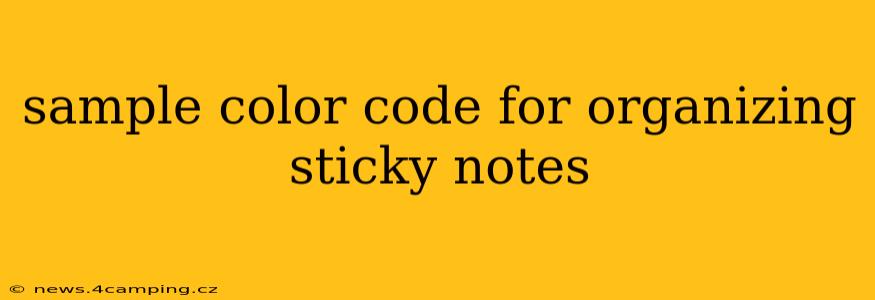Sticky notes are a fantastic tool for organization, brainstorming, and project management. But with a multitude of colors available, choosing a system can be overwhelming. This guide provides sample color codes and strategies to maximize your sticky note organization, helping you achieve peak productivity. We'll explore different color-coding schemes and answer common questions to get you started.
Why Use a Color-Coding System for Sticky Notes?
Before diving into specific color codes, let's understand the benefits. A consistent color-coding system transforms a pile of sticky notes into a visually appealing and easily navigable system. This allows for:
- Improved Visual Organization: Quickly identify and locate specific notes based on color.
- Enhanced Categorization: Group similar tasks, ideas, or projects by assigning them a specific color.
- Better Prioritization: Use colors to highlight urgent or important tasks.
- Increased Efficiency: Spend less time searching and more time working.
Sample Color Codes & Their Applications
Here are a few sample color-coding systems you can adapt to your needs. Remember, the key is consistency. Choose a system and stick with it!
System 1: The Rainbow Method (for multiple projects/categories)
This system utilizes the full spectrum of colors, assigning a unique color to each project or category.
- Red: Urgent tasks/deadlines
- Orange: Planning/brainstorming sessions
- Yellow: Ideas/inspiration
- Green: Completed tasks/achievements
- Blue: Meetings/appointments
- Indigo: Research/data collection
- Violet: Review/feedback
System 2: The Traffic Light System (for prioritization)
This system focuses on prioritization, using colors to quickly identify task urgency.
- Red: High priority – urgent and critical tasks
- Yellow: Medium priority – important tasks requiring attention
- Green: Low priority – tasks that can be addressed later
System 3: The Project-Based System (for individual projects)
This system is ideal for managing individual projects with multiple stages.
- Yellow: Project planning
- Blue: Tasks in progress
- Green: Tasks completed
- Pink: Review/feedback needed
How to Choose the Right Color Code for You
The best color code is the one that works best for you. Consider these factors:
- Your Personal Preferences: Choose colors you find visually appealing and easy to distinguish.
- The Number of Categories: A rainbow system works well for many categories, while a traffic light system is better for prioritization.
- Your Work Style: Choose a system that aligns with how you manage your tasks and projects.
What if I run out of colors?
Don't worry if you need more categories than colors! You can combine strategies:
- Use Shades and Tints: Light blue, dark blue, etc.
- Add Patterns: Use stripes or dots on certain colors to further differentiate.
- Use Different Sizes: Larger notes for major tasks, smaller notes for subtasks.
What are some common sticky note color associations?
While there's no universal standard, certain colors are commonly associated with specific meanings:
- Red: Often signifies urgency, importance, or warnings.
- Green: Generally indicates completion, success, or positive outcomes.
- Yellow: Frequently represents ideas, inspiration, or reminders.
- Blue: Often used for information, planning, or meetings.
What are the best brands of sticky notes for color-coding?
Many brands offer a wide range of colors. Consider exploring options from popular brands like 3M Post-it, Scotch, and others. Focus on the quality of the adhesive and paper to ensure your notes stay in place and are easy to write on.
By implementing a consistent color-coding system and choosing the right strategy, you can transform your sticky note usage from chaotic to organized. Experiment with different systems and find what works best for your unique workflow. Remember, consistency is key to making this system truly effective.
